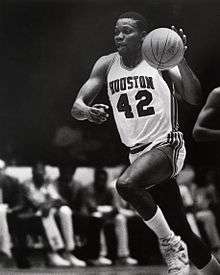Phi Slama Jama
Phi Slama Jama was the nickname given to the University of Houston's men's basketball teams from 1982 to 1984. Coined by former Houston Post sportswriter Thomas Bonk in a January 3, 1983 article, the nickname was quickly adopted by the players and even appeared on team warmup suits by the middle of the 1982–83 season. The teams were coached by Guy V. Lewis and featured future Hall of Fame and NBA Top 50 players Hakeem Olajuwon and Clyde Drexler. "Texas's Tallest Fraternity" was especially known for its slam dunking and explosive, fast-breaking style of play.
Philosophy

Phi Slama Jama played a frenetic, playground-influenced style of basketball that was in near diametric opposition to the fundamentally polished and methodical style espoused by basketball traditionalists like John Wooden. Wooden maligned dunking as flamboyant and unsportsmanlike and even forbade his players from performing the shot for several years. Guy Lewis not only condoned his players dunking, he "insisted on it", dunks being what he called "high-percentage shots."
The young players who made up Phi Slama Jama had been influenced by the freewheeling style of play pioneered during the 1970s by the defunct ABA and its most famous player, Julius Erving of the Virginia Squires and New York Nets. In this paradigm, athleticism took precedence over fundamental skills, fast breaks were preferred to set plays, and dunking trumped the jump shot. In an interview with Thomas Bonk, Clyde Drexler succinctly espoused the Phi Slama Jama philosophy, saying, "Sure, 15-footers are fine, but I like to dunk." The Phi Slama Jama teams were notably poor at free throw shooting, with some critics attributing their 1983 NCAA Final loss to this deficiency.
On the court
The Phi Slama Jama Cougars advanced to the NCAA Final Four each year from 1982 to 1984. As underclassmen in 1981–82, a young Cougar team lost to the eventual champion North Carolina Tar Heels in the national semifinals. The 1982–83 season marked the high point of Phi Slama Jama. The Cougars posted an Associated Press #1 ranking, a 31–2 record and a 26-game winning streak before losing in the NCAA Final. Considered one of the most unlikely upsets in NCAA tournament history, Phi Slama Jama lost a closely contested championship game against the North Carolina State Wolfpack by a score of 54–52. Ironically, the final margin was decided on a last-second dunk by Wolfpack forward Lorenzo Charles.
Despite the early departure of star forward Clyde Drexler after the 82–83 season, Phi Slama Jama continued their success in 1984. Hakeem Olajuwon became the focal point of the team and was selected as a consensus first team All-American. Guard Michael Young was also selected to the All-America team and led the Cougars in scoring for the second consecutive year. The Cougars returned to the Final Four once more, this time losing to the Patrick Ewing-led Georgetown Hoyas in the final. Olajuwon, with one year of eligibility remaining, declared for the NBA draft shortly after the loss in the title game. He was selected first overall by the Houston Rockets in a draft class that included Michael Jordan, Charles Barkley and John Stockton. Michael Young was also selected in the first round, chosen 24th by the Boston Celtics. The departures of Olajuwon and Young after the 1984 NCAA Final, in addition to the loss of Drexler and Larry Micheaux the previous year, brought the Phi Slama Jama era at UH to a close.
The Team
The team members during the Phi Slama Jama era are listed below, along with a few nicknames for which they came to be known. Many of these nicknames were coined by then-public address announcer and UH graduate Jim Nantz, who was a member of the Cougar golf team and roommate of Fred Couples.

The team included:
- Hakeem "The Dream" Olajuwon (AKA Akeem Olajuwon)
- Benny "Bomber from Bernice" Anders
- Clyde "The Glide" Drexler
- Larry "Mr. Mean" Micheaux
- Michael "Silent Assassin" Young
- Sean "Stretch" MacRitchie
- Lynden Rose
Renaldo Thomas
- Alvin Franklin
- Rob Williams
- Reid Gettys
- Rickie Winslow
- Greg "Cadillac" Anderson
- Dave Rose Co-Captain (1982–83)
Impact on the game

Though it was pioneered largely in the ABA, Phi Slama Jama is widely credited with popularizing the athletic "above the rim" style of play that pervades college basketball to the present day. Phi Slama Jama achieved its greatest prominence at a time when the overall popularity of basketball was burgeoning. Their entertaining style of play appealed to a broad audience, and helped to bring many casual fans to the sport. Olajuwon's international origin foreshadowed the worldwide explosion in the popularity of basketball in the 1980s and 1990s. In light of his unprecedented success, college basketball recruiters fanned out across the globe in search of the next undiscovered superstar. The legacy of Phi Slama Jama has remained at the fore of basketball discourse thanks in large part to the long and distinguished professional careers of Olajuwon and Clyde Drexler.
Having already helped to popularize college basketball with "The Game of the Century" in 1968, the Cougars' captivating 1983 postseason run again helped college basketball in its drive to join the first rank of major sports. The #1 vs. #2 clash of titans between Phi Slama Jama and Louisville's "Doctors of Dunk" in the Final Four served as an enthralling preamble to the dramatic title game. Ironically, Phi Slama Jama's title game loss to North Carolina State is widely considered their most immediate contribution towards putting NCAA basketball on a par with college football in terms of television viewership and revenue. The Cougars' last-second loss in the final was an iconic moment in the history of "March Madness" that helped to establish the NCAA Basketball Tournament as a major television event. The CBS broadcast of the 1983 Final between Houston and NC State drew 18.6 million households and the Houston-Louisville national semifinal attracted 14.8 million, both ratings records at the time for national final and semifinal games.